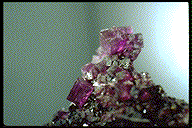

- Chemistry: Pb2AgCl3(F, OH)2, Lead Silver Chloride Fluoride Hydroxide.
- Class: Halides
- Uses: Only as mineral specimens.
Specimens
Bideauxite was named for American mineralogist Richard A. Bideaux.
Its type locality of Mammoth-St Anthony Mine, Tiger, Pinal County,
Arizona, USA is famous for wonderful lead minerals.
Other lead minerals from here include
phosgenite,
Bideauxite is a beautiful mineral. It forms well shaped cubic crystals that look like fluorite cubes. The color however is more variable than most fluorite specimens which are either strongly colored or colorless, but usually not both. In bideauxite, there can be deep purple colors in the crystal cores with strikingly colorless exteriors. Also in the same specimens there can be deeply colored cubes nested beside perfectly colorless cubes. The lack of cleavage and greater density for bideauxite are diagnostic in distinguishing it from fluorite. Unfortunately for collectors, bideauxite is extremely rare and hard to find on the mineral market.
Bideauxite and others minerals with similar chemistries belong to a division in the Halide Class called the Oxyhalides and Hydroxyhalides.
These minerals have either oxygen or hydroxide groups in their chemistries.
The oxygen atom in their chemistries might require their classification in the
Oxides Class
of minerals except that their structures are more tied to the halide elements and the oxygens and hydroxides are kind of superfluous to the overall structure.
Some other members of the Oxyhalides and Hydroxyhalides include
boleite,
PHYSICAL CHARACTERISTICS:
- Color is colorless, white, pale violet to lavender.
- Luster is adamantine.
- Transparency: Crystals are transparent to translucent.
- Crystal System is isometric; 4/m bar 3 2/m.
- Crystal Habits include cubic crystals that envelope boleite crystals and often completely replace them.
- Cleavage is absent.
- Fracture is uneven.
- Hardness is 3.
- Specific Gravity is 6.3 (very heavy for translucent minerals)
- Streak is white.
- Other Characteristics: Index of refraction equals 2.192 (very high).
- Associated Minerals include
boleite,
matlockite , cerussite, anglesite, leadhillite and galena. - Notable Occurrences include the type locality of Mammoth-St Anthony Mine, Tiger, Pinal County, Arizona, USA and Chile.
- Best Field Indicators are crystal habit, color, density, luster, lack of cleavage and locality.





